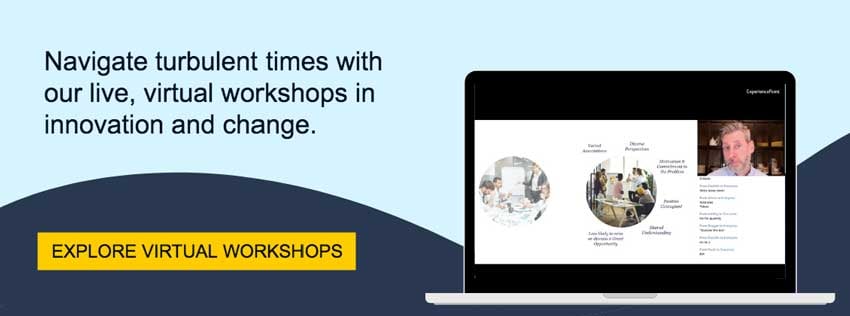In speeding products to market, businesses frequently fall back on their own bias — endeavoring to create products and services they think their customers might need or want without ever engaging the customers themselves.
And in that same ever-changing marketplace, where survival relies on profound and unyielding innovation, we know that bias and assumption stagnate creativity, leaving products on the dusty shelf of “what always was” rather than pushing them towards “what could be”.
It’s a familiar and unforgiving loop — and one that no design team is wholly immune to. This is why employing the human-centered method, which consistently challenges natural human assumptions while yielding to unique necessities of time and resource, is proving essential to innovation leaders all over the world.
From its signature ‘how might we’ question to its embracing of diverse perspectives and divergent ideas, the core steps of the human-centered design method are infused with the bias-busting capability that ignites innovation. Yet while the method is also iterative by nature, there are numerous additional techniques that can be applied at the outset or during any human-centered design journey, based on the unique circumstances and objectives a given team.
Here are just a few techniques leveraged by ExperiencePoint’s own Product Team to combat bias and unlock innovation:
Acknowledging Bias at Outset: Unsurprisingly, the ExperiencePoint Product Team leverages the company’s own unique human-centered design process in order to develop its own innovative and customer-focused products. Before entering into any design cycle, the team finds it useful to acknowledge the presence of bias by engaging in assumption-related exercises such as the Harvard Implicit Association Test. This exercise is not a pass or fail endeavor, but a useful tool to measure the strength of associations between concepts, evaluations and stereotypes. It allows designers to recognize that bias is a natural and oftentimes unconscious happenstance that must be actively guarded throughout the design process.
Role of Language in Collaboration: There are many unique ways that human-centered design teams seek to ignite open and honest collaboration and to break through barriers of bias and fear to unlock wild, divergent and innovative ideas. Yet often the importance of language is forgotten in the process. In an article published by Zendesk on how word choice can sabotage workplace collaboration, Camilla Vasquez Professor of Applied Linguistics at the University of South Florida, explains that language is ambiguous and polysemous and as such, humans are often caught unaware of how their language choices we make impact other people’s perceptions.
This is why ExperiencePoint’s Product Team is deliberate in their language choices during periods of collaboration. For example, team members are strongly encouraged to challenge one another’s ideas and possible assumptions but to do so productively: the expression of “I don’t agree” or “I think the opposite” would in this way be presented as “I wonder if…” or “to build on that thought…”. Further, the word “problem” is often replaced by “challenge” or “opportunity”, and even terms such as “extreme users” (common to the human-centered design community) have been reimagined —sometimes as “diverse users” — to broaden its connotation.
Asking Core Questions: Inspired by The Creative Independent’s Designing for Diversity guide, ExperiencePoint’s Product Team considers, explores and returns to these four key questions during their design process to break through walls of bias and assumption:
-
What’s the worst-case scenario that could result from this solution, and who would it affect?
-
How do the identities within our team influence and impact your design decisions?
-
Who might our product, service or solution be excluding?
-
How will we seek to engage the people we want to reach within our design process, equitably?
